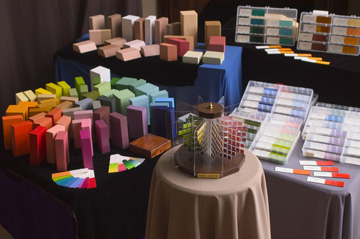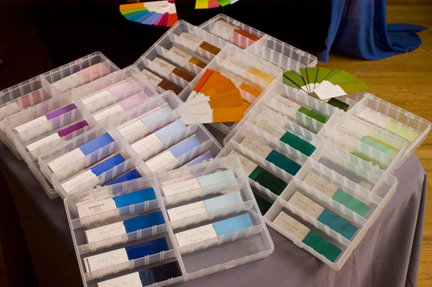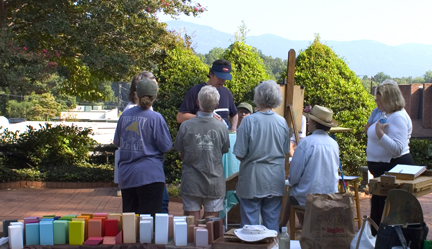|
MORE ABOUT THE THOMAS NASH COLOR WORKSHOP
The Thomas Nash COLOR workshop is a unique and valuable learning experience for artists of
all levels and interests. It will be a huge help to those working not only in portraiture but still life and landscape too.
It is designed so that artists will come away with a sharply increased ability to see, understand, mix and paint the
colors before them.


Some of the many aids Nash uses in teaching about color.
He will employ his famous collection of painted "color tabs" to illustrate combinations, illusions and eye opening
revelations about colors we all thought we knew. Participants will become intimately familiar with the possibilities
and limitations of their paints. He will demonstrate and explain multiple approaches to mixing and using color. With
slide presentations, and by example Tom will teach the principles of color control in the real world so that artists
can create any color they want quickly and easily.

In this Tryon NC Color Workshop Nash employed the Hensche Blocks to teach observation and mixing of color.
He will share what he learned from Henry Hensche and his
impressionistic approach to color while showing also how something very scientific such as the Munsell
system can be incorporated as a useful addition to any artist's repertoire. It will not be all theory or lecture though.
The artists will create simple paintings during class as exercises to reinforce what they learn.
It is a hands on experience.
Some Topics Covered:
- Four specific pitfalls to avoid when mixing color.
- The pros and cons of the various ways to neutralize a color.
- Cross mixing around the color wheel to control your color mixtures precisely.
- Adjusting hue, value and chroma simultaneously.
- When to "sneak up" on a color and when to "go for it".
- Strings of color: The principles behind creating useful assortments of premixed colors based on what you see, rather than by formula.
- Multiple ways to mix the same color and why you might use one or the other in a given situation.
- The benefits and drawbacks of a limited palette
- The benefits and drawbacks of a very extensive palette
- Dealing with the range of paint compared to light and how artists have handled that historically.
- Why you might select a given color or value key in a given situation.
- Why and how realistic painters can paint very differently from one another and still capture a truthful authentic effect.
- How using deduction and knowledge of a hues' "home chroma" can help you solve color problems.
- The difference between copying and reading a scene's colors.
- Seeing through the illusions, not being fooled by simultaneous contrast.
Return To Color Workshop Information
|

